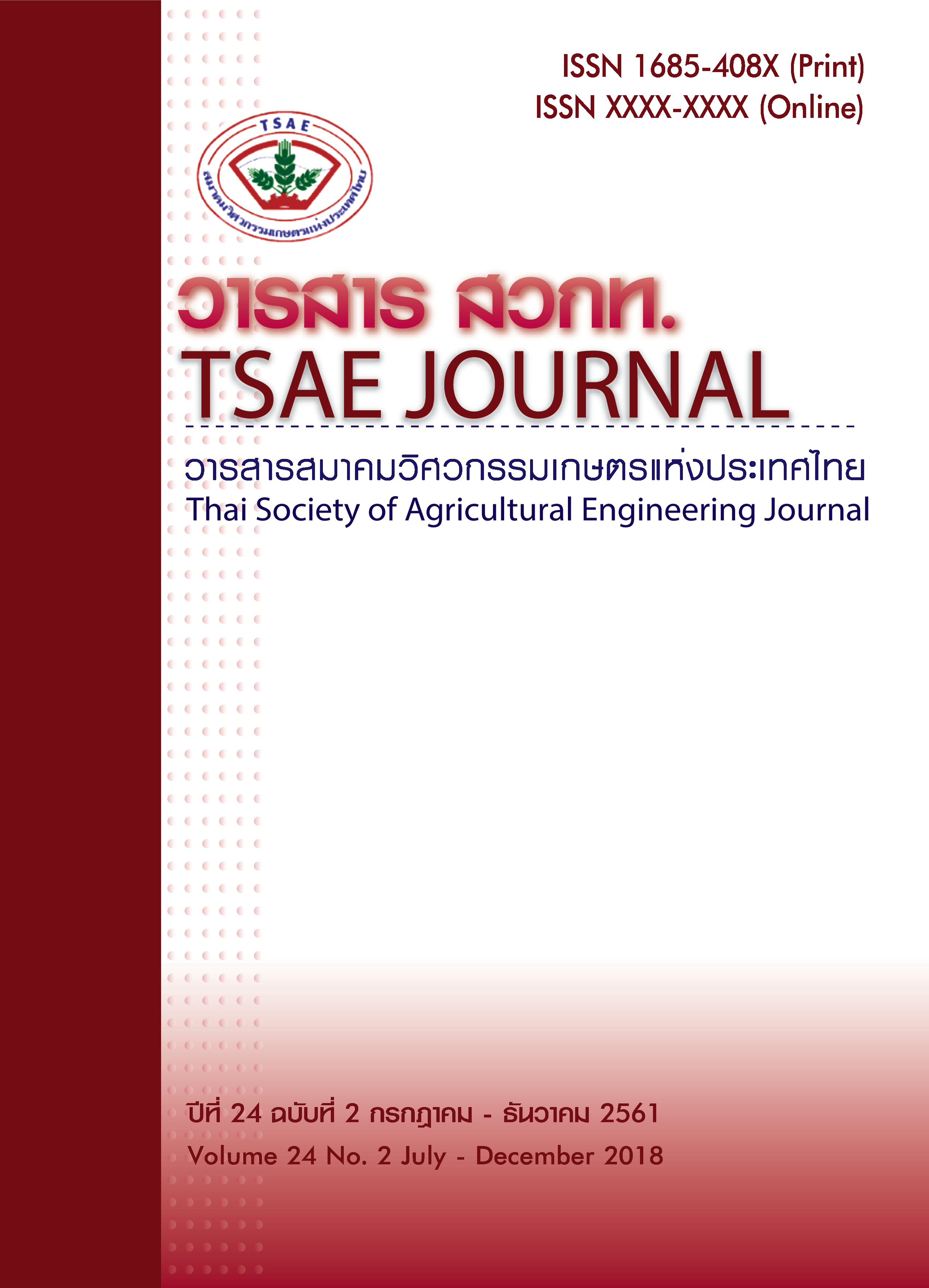การศึกษากระบวนการผลิตน้ำสกัดจากเนื้อมะพร้าว, Study of Coconut Meat Water Extraction Process
Main Article Content
บทคัดย่อ
งานวิจัยนี้เป็นการศึกษากระบวนการผลิตน้ำสกัดจากเนื้อมะพร้าว เพื่อหาเงื่อนไขการตกตะกอนของโปรตีนในน้ำนมมะพร้าว โดยนำน้ำนมมะพร้าวให้ความร้อนที่อุณหภูมิ 75 85 และ 95 °C เป็นเวลา 3 15 และ 30 นาที แล้วกรองตะกอนด้วยผ้ากรอง 100 ไมครอน จากผลการทดลอง ที่อุณหภูมิ 75 °C ได้ตะกอนโปรตีนไ 1.24 1.55 และ 1.62 % โดยน้ำหนัก ที่อุณหภูมิ 85 °C ได้ตะกอนโปรตีน 7.80 8.40 และ 12.34 % โดยน้ำหนัก และที่อุณหภูมิ 95 °C ได้ตะกอนโปรตีน 11.24 14.14 และ 14.71 % โดยน้ำหนัก ตามลำดับเวลา พบว่าที่ อุณหภูมิ 95 °C โดยใช้เวลา 15 นาที เป็นเงื่อนไขที่เหมาะสมและมีความแตกต่างกันอย่างมีนัยสำคัญที่ระดับความเชื่อมั่น 95% เนื่องจากแยกตะกอนโปรตีนได้ดีและใช้เวลาน้อย จากนั้นศึกษาการแยกตะกอนออกจากน้ำสกัดจากเนื้อมะพร้าว โดยใช้เครื่องแยกแบบแรงเหวี่ยง (Disc and bowl centrifugal separator) ที่ความเร็วรอบ 10,500 rpm โดยกำหนดอัตราการไหลเข้าเป็น 4 ระดับ คือ 51 175 293 และ 529 ml min-1 แล้วนำไปหาปริมาณตะกอนโปรตีนที่ตกค้างอยู่ พบว่า ที่อัตราการไหล 51 175 293 และ 529 ml min-1 ได้ตะกอนที่ตกค้างอยู่ 1.57 1.26 1.92 และ 1.98 % โดยน้ำหนัก ตามลำดับ จึงสรุปได้ว่า ที่อัตราการไหล 175 ml min-1 เหมาะสมที่สุดและมีความแตกต่างกันอย่างมีนัยสำคัญระดับความเชื่อมั่น 95%
This research is to study the process of coconut milk extraction. The sedimentation conditions of curd of skimmed coconut milk (scm) was studied. The scm was heated at 75, 85 and 95 °C for 3, 15 and 30 minutes and then filtered with 100 micron filter. The results showed that the curd of scm content was 1.24, 1.55 and 1.62 % by weight respectively. At 85 °C, curd of scm content was 7.80, 8.40 and 12.34% by weight respectively and at 95 °C, coconut milk protein precipitation was 11.24, 14.14 and 14.71% by weight respectively time sequence. The result can be concluded that 95 °C for 15 minutes is the optimal condition and significantly different at 95% of confidence interval, due to high protein content and less time. Then, the sedimentation of the coconut water extract was studied again, by using continuous a disc and bowl centrifugal separator. At a speed of 10,500 rpm, the flow rates are 3 levels: 51, 175, 293 and 529 ml min-1. The flow rates of 51, 175 293 and 529 ml min-1 had the remaining sediment of 1.57, 1.26, 1.92 and 1.98% by weight, respectively. Conclusions, the optimum flow rate is 175 ml min-1 and significantly different at 95% of confidence interval.
Article Details
สมาคมวิศวกรรมเกษตรแห่งประเทศไทย
Thai Socities of Agricultural Engineering
เอกสารอ้างอิง
2. สำนักงานเศรษฐกิจการเกษตร. 2559. สถิติการเกษตรของ ประเทศไทย ปี 2559. แหล่งข้อมูล: https://www.oae.go.th/download/download_journal/2560/yearbook59.pdf. เข้าถึงเมื่อ 1 กุมภาพันธ์ 2561.
3. Birosel, D.M., Gonzales, A.L. and Santos, M.P. 1963. The nature and properties of the emulsifier system of oil globulins in coconut milk and cream. The Philippines Journal of Science. 92(1): 1-15.
4. Dickinson, E. and Stainsby, G.1982. Colloids in Foods. Applied Science Publishers, London.
5. Dziezak, J. 1988. Emulsifier: the interfacial key to emulsion stability. Food Technology. 42:172- 186.
6. Steinkraus, K.H., David, L.T., Ramos, L-J. and Banzon, J. 1968. Development of flavored soymilks and soy/coconut milks for the Philippine market. Philippines Agricultural Scientist. 52: 268-276.


